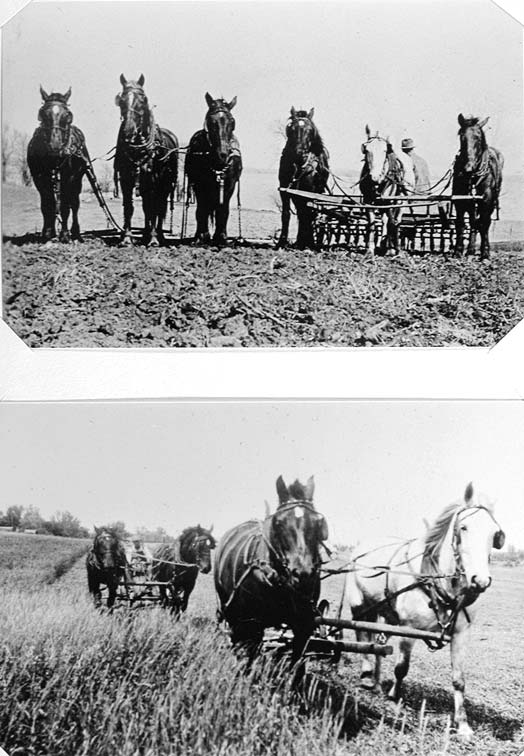Farming With Horses
Top: Two horse teams, disking and dragging.
Bottom: Cutting grain in field near Ashby, circa 1932; Polly and Bird in front.
Excerpt from Donald B. Johnson manuscript:
"We had the blacksmith make a tandem disk by reversing the blades on a horse disk and attaching it to the back of another horse disk. We drove eight horses on that, four and four, sometimes with as many as four unbroken 3-year-old colts in the back team. Of course, we were only 'one-horse' farmers compared to the ones who were developing the big hitches in southern Minnesota and Iowa. They were driving up to a dozen horses, in three teams, with only two lines, for plowing and disking."
"We were advertising horses when a fellow came from north of Underwood and described a young, sorrel horse.
"We had a big, bay 3-year-old we broke that was too gentle and lackadaisical to suit me. He said his horse didn't match anything he had and our bay did. Pa didn't want to drive clear up there to trade a really good horse for one that there was no doubt something wrong with, but I kept needling him until he said I could go up and see what the other horse looked like.
"When I got back, he said, 'What does he look like?'
"'I traded even,' I said. That was about as aghast as I ever saw Pa look. [27.183-1]
"After the other fellow came down and switched horses, we took the sorrel out to the edge of the field and hitched him to a wagon and hay rack with our biggest, gentlest old mare. Pa and I were both on the wagon. He told them to go, and we went on a really wild ride. I had traded for a runaway!
"Old Molly could hardly keep up, but there wasn't much she could do but go along. We tried to keep them on the loose, plowed field until they finally got tired and stopped.
"We unhitched them right there in the middle of the field and went for the breaking harness. That had trip ropes on it and when a horse would make a false move we could trip him right on his nose and hold him there. In no time at all that runaway was our third best lead horse and forgot all about running away.
"We broke all our horses with trip ropes on the front feet before we hitched them to anything, so if they stepped into the eveners in front of them or got anything tangled up with their feet (like fences) they would stop and stand 'stock still' and not smash things up." [27.183-2]
"One day Pa broke something on the machinery he was using and had a new part out at the farm. He left the four horses standing in the field behind the school, still hooked to the piece of machinery that had broken down, and went home with the car and got it. The horses didn't move an inch while he was gone. We had all our older horses broken well enough that we could do that anytime. Sometimes out at the farm we would leave them like that and walk up to the house for coffee." [13.73-4]
Previous • Next • Contents • About • Sitemap • Home
